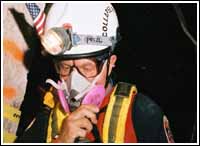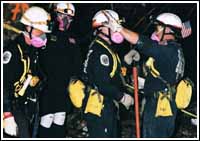Safety Equipment Needs
The respiratory protection that search and rescue workers need are
1/2 mask respirators with N-R-or P series filters with an efficiency
rating of 95 or greater. This is the filter portion of the respirator
and does nothing for gases or smells from the decaying bodies. They
also need an organic vapor/acid gas canister which absorbs odors
and harmful gases.
Sanitation of respirators is necessary to ensure
that the air is clean within the mouthpiece. In addition, any workers
that are welding or cutting metal beams etc. need welding face shields
and welding goggles and shields.
Here is the list of PPE (personal protective
equipment) needs:
- Half mask or full face air purifying respirators
with N-R- or P, 95 or greater filters and OV/AG canisters.
- Welding face shields with auto-darkening
lenses.
- Neoprene, nitrile gloves
- Protective eyewear or goggles
- Hard hats
- Limited use-protective clothing such as
Kimberly Clark's SMS suits, Dupont Tychem and Tyvek and Kappler
Proshield and Proshield 2 full body protective suits that do not
require decontamination.
|
Correct Use of Safety Equipment
- Choose a mask that filters the toxins you
will be in contact with. Canister respirators are better than
particle masks. Paper and cloth filters are useless
- Make sure the mask fits you well
- Put the mask on, put all straps in place,
and tighten the straps
- Keep the mask on! It is useless around
your neck; take your breaks in clean air
-
Change your mask's filters
as often as needed (if you can smell toxins, or need to breathe
harder than before, it's time to change the filters)
-
Full face masks are best;
otherwise, choose and use appropriate eye protection (not regular
eye glasses)
-
Wear protective suits; do
not allow contaminated clothes or shoes to go into your home
or car (at the very least, set aside a set of clothes just for
rescue work, keep it in a plastic bag, and throw it out when
you are done--do not wash contaminated clothes with other clothes)
-
Use other protective gear
(hard hat, gloves, boots, etc) as required
-
Err on the side of caution;
use the safety equipment required by the worst case scenario
- Work with the equipment. Think of
it as an extension of your skin, not as an annoyance. It will
help you do your job better and keep you healthy so you can keep
working
|
|
|
Arlington, VA, September 13, 2001 --
Urban Search and Rescue crews from Montgomery County work to clear debris
and strengthen support at the crash site following Tuesday's attack. Photo
by Jocelyn Augustino/ FEMA News Photo
|
Arlington, VA, September 13, 2001 --
Urban Search and Rescue crews from Montgomery County work to clear debris
and strengthen support at the crash site following Tuesday's attack. Photo
by Jocelyn Augustino/ FEMA News Photo
|

